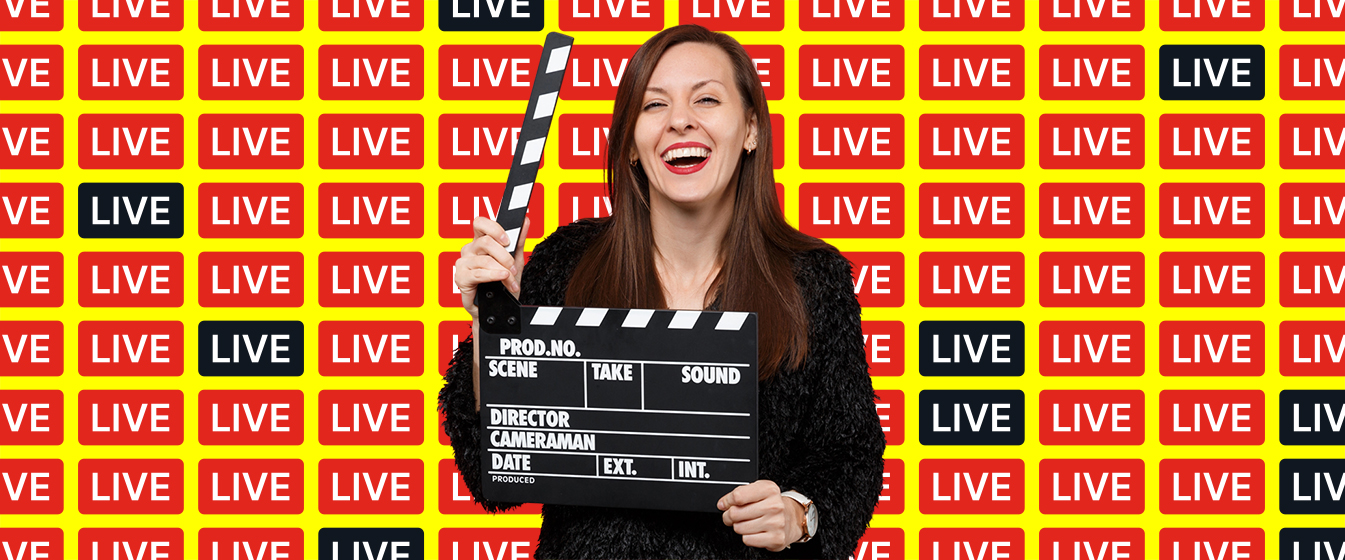Blog: Event management
Seven event trends to look out for in 2023
11 January 2023 minute read

Nearly three years after the first lockdowns, we’re still discovering new seismic shifts in society — nowhere more so than in events.
Going into 2023, the collective yearning for connection is stronger than ever. But it’s also evolving.
Here’s our hot take on the ways business events will change in the year ahead, along with some ideas you can implement to get ahead of the curve.
In a nutshell, we see events being impacted most by seven mega-trends this this year:
1More digital
While in-person events are thriving post-pandemic, the genie is out of the bottle as far as the digitalisation of events is concerned.
Analysis from research firm Forrester suggests that 58% of marketers expect their flagship B2B events to remain hybrid, and this looks set to continue in 2023.
A whopping 76% of event owners surveyed believe they have increased reach and attendance through the digital transformation of their events.
We see the undeniable combination of inclusivity, seamlessness and sustainability as the key reasons why hybrid will hold its ground in the year ahead as event managers look to take the benefits of virtual events and translate them into physical ones.
Marketers are starting to ditch the binary thinking that pits physical and virtual events against one another, focusing instead on building experiences that match personalised content with individual attendees in the format they prefer – whether at a conference centre, through a browser, or a mix of the two.
Moving forward, event strategies will focus on engagement and impact rather than format, reaching attendees where they prefer to interact.
So, think about how to integrate more digital interactions into your in-person events throughout the journey – pre-event, at the event and post-event. For example, use web/mobile app experiences pre-event to deliver personalised agendas. At the event, use polls and surveys to get event and session feedback, and post-event offer on-demand content to attendees.
2More transformative
Whether you’re planning a conference, trade show, product launch or all-hands meeting, the fundamental goal of events is to transform people.
Maybe you want them to create a community around your company, or promote your brand, or just buy from you. But you’ll want to get your attendees to think, feel, and behave differently.
Transformation lies at the core of the event experience.
The total disruption of the business world in 2020 called into question the purpose of events in society as a whole. People started to ask: ‘Is this really essential? Do I have to be there? Can I just get the information on my computer?’
Elite event managers are responding to this by creating extraordinary experiences that aim to take attendees out of their daily routine and plant them into a totally different environment – one centred around creative engagement and self-actualisation, rather than just the passive consumption of content.
Easy to say, tougher to achieve! But we see the more forward-looking organisations working on approaches like:
Encouraging people to participate in co-creative activities
Fewer didactic presentations, more thoughtfully facilitated group discussions centred around collective problem-solving.
Providing the right environment for meaningful interactions
Less focus on random swapping of business cards during coffee breaks, more careful engineering of meaningful interactions between stakeholders with interests that are truly aligned.
Applying storytelling techniques to the event
Wrapping the event narrative into a story with a ‘hero’ (perhaps your company or brand) and a villain (the challenges your attendees face on their way to success).
Nobody expects the ‘World Sanitation Conference’ to turn into a version of ‘Burning Man’ overnight. Start small and experiment. The key is to think more about the emotions and feelings your attendees will experience, rather than just the content you’ll give them.

3More video
Video is already the biggest deal in digital marketing. In 2023 it will get bigger.
According to The Cisco Video Networking Index, video content will account for 82% of all internet traffic by the end of the year.
Not surprising when you think about where your attendees spend their time today. They’re on TikTok or they’re on streaming platforms like Netflix, consuming snackable video content, on-demand, when it suits them.
If you haven’t incorporated video your event marketing campaign, you’re missing some huge opportunities – from authentic connection to simplicity in sharing messaging to revving up email engagement.
Most event organisers have hidden riches in the form of b-roll video, testimonials and interviews with influential speakers, sponsors and attendees – along with other video assets (think exhibitor demos).
Often, they have more source material that they realise.
Maybe they don’t think they have the time to edit, re-package and re-use all this good stuff, but these days, it’s easier and cheaper than ever to do just that.
Look on Fiverr or similar sites and you’ll find cost-effective post-production experts who can turn your hours of b-roll into full-length and snippet video for website, media, paid and organic social and email.
And when it comes to content from the event itself (actual presentations, panels, keynotes etc) this appetite for on-demand video represents an opportunity to merge your event outputs with other digital marketing strategies, and for marketing teams to align with event teams to plan and distribute event video content pre-event, at the event and post-event.
For example, consider creating an on-demand content hub where attendees can access speaker sessions and other exclusive content from your event.
4More environmentally conscious
I know, we’ve all heard this one before, but wait. 2022 saw climate crisis and sustainability issues rise to the top of almost everyone’s agenda. There has been a marked shift in the attention that sustainable aspects of live events have been getting.
From venues promising to be as environmentally friendly as possible to event stand suppliers offering only sustainable and reusable solutions to help bring down waste.
2023 will be the year where being environmentally conscious is no longer a ‘nice-to-have’ but a necessity. Events that don’t work to minimise their carbon footprints will suffer reputation damage and some attendees will vote with their feet.
So (if you’re not already) it’s time to think about reducing (if not eliminating) printed on-site collateral and going digital with attendee apps.
Eliminating plastic from your catering, badging and merchandise is no longer as difficult (or expensive) as it was a few years ago thanks to some great new innovations.
How much do you know about the environmental credentials of your venue? Do they use smart temperature controls? Do they have water-efficiency mechanisms in place? Do they have recycling stations available? Same with your exhibition contractors: do they recycle / re-use those trucks full of staging, temporary structures and signage, or is it all one-and-done?
Depending on your location and scale, it can be worth teaming up with your local transport authority to include free travelcards, making it more attractive for attendees to use mass transit, bikeshare etc during the event.

5More accessible and inclusive
Like sustainability – Diversity, Equity, and Inclusion (or DE&I) is moving from the ‘desirable’ to the ‘essential’ column this year.
Wherever we look, we’re seeing a higher priority placed on ensuring events are accessible and inclusive to all individuals, which chimes with last year’s AMEX Global Event Trends Forecast which had 87% of respondents saying their organisations were actively working to incorporate DE&I into their meetings and events.
Whether it’s taking steps to avoid unconscious bias in your speaker selection process, ensuring your chosen venue is fully accessible, or being more aware of the language used in communications and at the event itself, there are plenty of areas we can work on to deliver experiences that are inclusive for everyone.
A particular challenge we expect to see gaining more attention in 2023 is event design that better meets the needs of the neurodivergent community. Expect to see more spaces at large events and conferences that allow attendees to ‘escape’ for a bit by taking breaks in less stimulating spaces and even allowing for time outside in fresh air. Similarly, look out for event programming with more frequent breaks in content and breakout sessions with fewer participants.
6More integrated
2023 is the year when more event planners will come to realise they really don’t need the headache of multiple event management tools, patched together with constantly shifting APIs.
All those logins; all those different interfaces; all that time; all that money; all those compromises. They’re on the way out for thousands of organisations this year.
A fully integrated event management software platform – that can handle events of all types – is now a must for events that want to deliver slick, secure and inclusive experiences across in-person and virtual.
The right integrated platform can now handle in-person, virtual and hybrid experiences seamlessly – from registration through to networking and audience engagement capabilities.
Marketers already know that the best events can still end up going to waste if they don’t have a reliable way to move leads further down the sales funnel or follow up with attendees in the right way. Consequently they’re shifting their thinking and placing a unified event management platform at the heart of a deeply integrated martech stack – along with their enterprise CRM and MA tools.
When it comes to marketing the event itself, that’s a whole lot harder if you’re using one system to create the event website, another to run the email marketing campaign, and yet another to manage contact data and follow-ups. Ideally, an event management platform should handle all of these things without breaking into a sweat.
And then there’s on-site. Pay thousands for a ‘custom’ app, then port all your attendee data in from scratch and start solving a bunch of new problems? Today’s unified platforms should include a state-of-the-art mobile attendee app with programme info, networking and engagement – while providing you with instant access to real-time performance insights.
The advantages of being able to streamline business workflows using a single unified platform are enormous. The power, convenience and cost-effectiveness of having one license, one log-in, and one support team ensures you have all the tools you need to plan, host and manage your event from start to finish.
7More financial pressure
We’ve saved the best (OK worst) ’til last.
Arguably the biggest challenge for event owners in 2023 will be managing and allocating budgets in a fraught economy.
What we’ve seen in 2022 is that, despite the rising cost of services and goods due to supply chain issues and inflation, companies are still placing a lot of value on events – both with their internal teams and external stakeholders.
Pent-up demand for in-person, combined with denuded post-pandemic capacity, means that most suppliers and venues are running hot as we start 2023.
Expect tighter budgets with a demand for more creative spending. What does that even look like? Who knows! But, after a period of recovery funds being disbursed and spent, organisations will now need to generate profit through more traditional means – exhibitor fees, member registration, event ticket sales, etc – while also uncovering newer revenue streams.
So expect minimum numbers and rental fees to continue inching upward while stricter payment terms will add to pressure on cashflows.
Work out which features or your event are must-haves and which are nice-to-haves. Check in with your attendees on this. Just because you think you need that ice sculpture vodka luge, doesn’t mean they wouldn’t show up without it.
Be prepared to rethink ticketing strategies – like considering introducing additional tiers to generate extra turnover.
Event professionals will have to have some frank conversations with bosses and clients about just how far budgets can really go this year.
One thing we know for sure is that thousands of organisations are paying way too much for legacy event technology, including per-attendee fees, set-up charges, branding packages and a bunch of other rip-off BS.
If you like the idea of paying a single, transparent fee for a comprehensive event platform that lets you run unlimited events with unlimited attendees, give us a call. That’s something we can help you solve.




